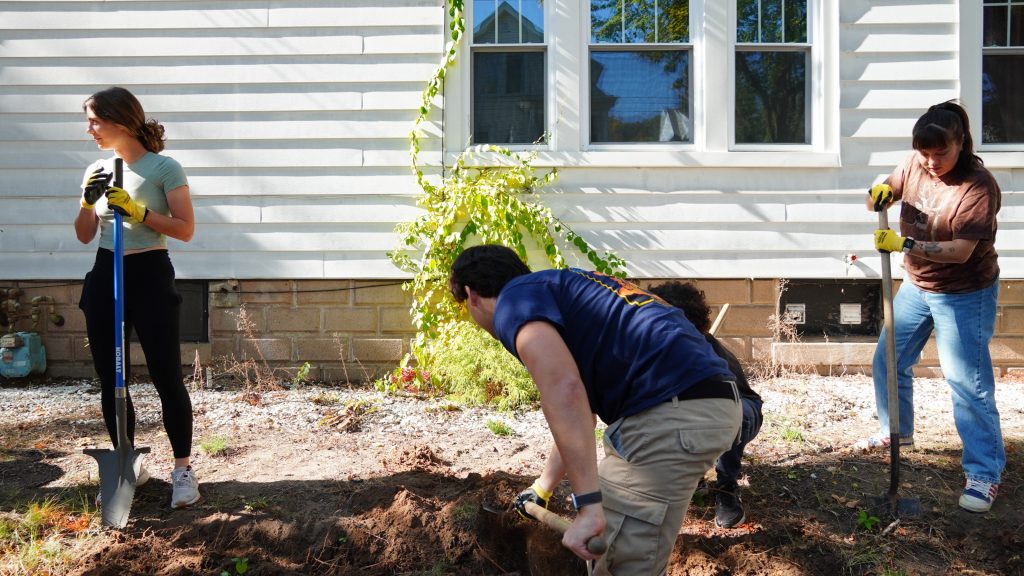by Lindsay Skedgell, Ecological Communications Specialist

On the lawn, a bright orange line is spray painted to carve the shape of a long, half horseshoe in the grass. Parked next to the yard is a U-Haul truck, loaded with 25 bags of cedar mulch, 12 bags of stone, gloves, and shovels. Lys Gant, Save the Sound’s watershed stewardship coordinator, and a Lowe’s employee loaded the truck in at nine in the morning.
Now it is afternoon and along the orange edges rows of potted plants wait to be placed in the soil. Black-eyed susan, butterfly weed, iris, button bush. Within hours, there will be a rain garden.

Rain gardens are a form of green infrastructure that help to lessen localized flooding, filter stormwater pollutants collected from impervious, manmade surfaces, and increase pollinator presence through native plants.
The residential rain garden program, which is led by Gant and Nicole Davis, Save the Sound’s watersheds project manager, will install 40 rain gardens in property owners’ yards throughout the New Haven neighborhoods of Fair Haven, Newhallville, Dixwell, Dwight, Amity, Mill River, and in South Hamden, free of charge. Nearly half of these rain gardens have already been installed.
“It’s exciting that we’re pulling from three different downspouts for this garden,” Gant says, pointing to the white pipes that transport rain from the roof to the yard. Today’s residential rain garden will infiltrate water from 785 square footage of captured roof area. In other words, roof water that would normally runoff, untreated, into the nearest storm drain during a rainstorm, will now be absorbed and cleaned by a rain garden, slowly filtering through the soil to replenish groundwater.


A class of conservation biology students from nearby Quinnipiac University are volunteering to help install today’s residential rain garden. Once they unload from their university van, things move quickly. They break ground with shovels and upturn topsoil with matted roots to build a berm, an outer wall that will help keep the rainwater in. They hand saw thick roots. “Are you sweating yet?” one student asks another. “Cause I’m close.”
While digging, volunteers find a shard of white plate, an old tube of lip gloss, a young beetle, a brick. The pace of installation speaks to what Gant refers to as an immersive, hands-on process, where volunteers jump right in to begin installation. Along the way they feel out, over time, what part of the process speaks most to them. A typical rain garden takes around three hours to install if working in a group.

While the average square footage for one of Save the Sound’s rain gardens hovers between 40 to 60 square feet, the one installed today is 113 square feet. Gabriela Campos, Save the Sound’s community leader assisting with the rain garden project, gathers potential rain garden spaces by door-to-door canvassing. She originally connected with Mi-Cha-El, today’s rain garden property owner, back in August, when a rain garden installation caught his attention while out delivering for FedEx. After learning more about the benefits, he decided to apply for one himself.
“It’s therapeutic,” Mi-Cha-El says about installing a rain garden. Though he once had a garden growing squash and vegetables along the left edge of his home, he discovered over time that he would need more support to maintain it. Starting a garden often has to be a community-led effort.

When asked by a student how Save the Sound’s green infrastructure team prioritizes rain garden installations, Campos says that as a Fair Haven resident, she tends to focus her canvassing efforts there first. “I wanted to go get something done that would immediately make an impact,” she says about her decision to get involved with the program.
Now, hours later, the black-eyed susans, the button bushes, the purple asters, are all in the ground, popping color in deep brown cedar mulch. The shovels have been loaded back into the truck. White stones have been placed at the foot of the downspouts. “They’re already coming,” someone says, pointing to a bee.
